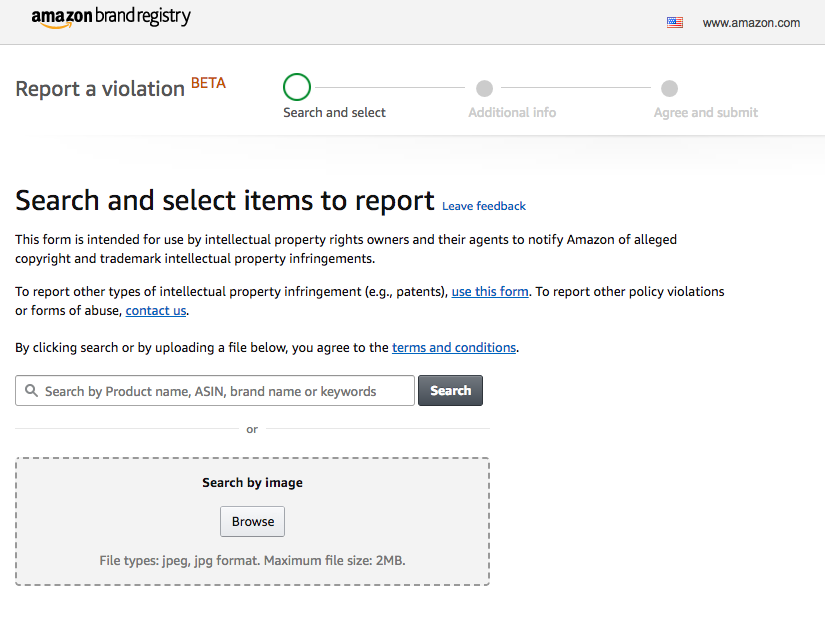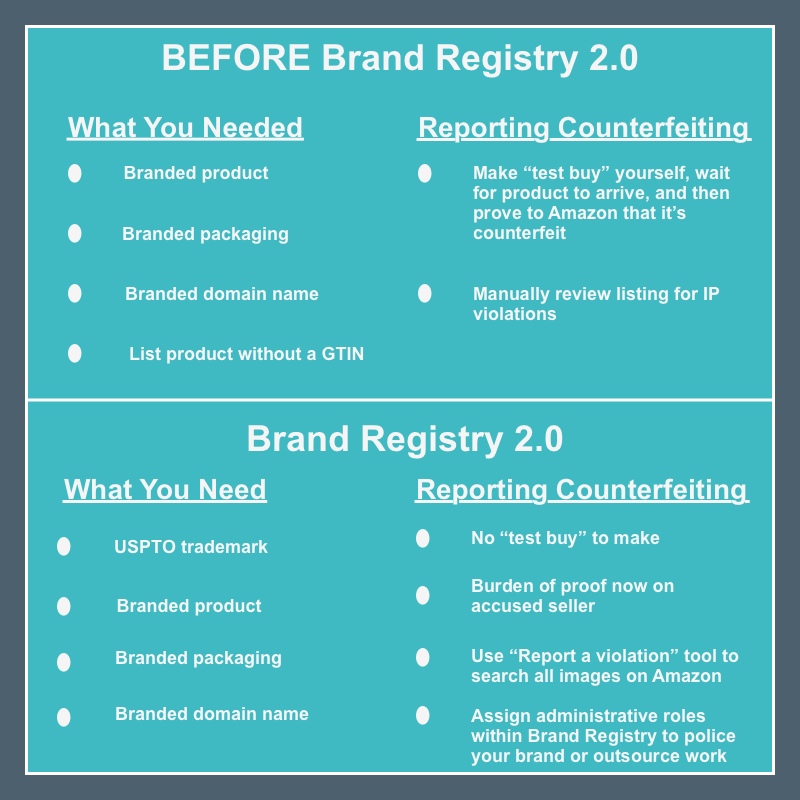The Amazon Brand Registry is a means for sellers and manufacturers to take control of their branded products on Amazon. Counterfeit goods and unauthorized sellers are a constant problem throughout the wide world of ecommerce, and Amazon is an especially tempting target due to its immense size. Until the launch of this revamped Brand Registry program, it was far easier to get away with fraud.
Until recently, counterfeiting was pretty difficult to prevent. Selling branded goods simply required that packaging, the product itself, and a domain name all had the brand’s name. Sellers who suspected counterfeiting was taking place had to place an order and examine the product themselves before reporting it to Amazon. The burden of proof was on them, rather than on the seller who was being accused.To combat the rise of counterfeiting and provide brands with more security around who can make changes to their product listings, Amazon launched “Version 2.0” of the Brand Registry program in May 2017. The new program includes a number of useful changes that make it much easier for sellers to maintain security. We’ll discuss these below.
What are the benefits of joining?
To start with, sellers no longer need to do any test buys themselves, nor does the burden of proof fall on them. Registered sellers need only contact Amazon to report counterfeiting or hijacking of listings, and Amazon promises to respond within four hours. As the registered brand owner, you will have the upper hand in the event of a dispute with another seller over a product listing, which means you’ll have a good deal more identity protection for your brand.
For many brands, if not most, goodwill and other intangibles are among the most valuable assets the brand possesses. These assets often take years of enormous effort to create, yet they can be eroded immediately if counterfeiting or poor quality from unauthorized sellers causes customers to have bad experiences or unflattering comments start to get around.
The primary difference between the original Brand Registry and the newly launched version is that you must now have a registered U.S. trademark for your brand to apply. While this is a much more rigorous standard to meet, it offers many legal protections once secured, including strong protection from the intangible kind of damage often done to brands by unscrupulous sellers. A final benefit is that inclusion in the new Brand Registry is required before sellers can access Enhanced Brand Content pages for FBA sellers or Amazon’s new Early Reviewer Program.
With this new program, Amazon is collecting more information in the application process—including your trademark, logo, and product design. By collecting this information upfront, Amazon makes it simpler to report violations of the intellectual property you have submitted. Within the new Brand Registry’s “Report a Violation” tool, you can do an image search against all images in Amazon’s catalog. It will detect any image using this visual search.

The support team handling reported violations seems to be more serious and timely in its responses than the general Seller Support team.
You can assign administrative roles within the Brand Registry. Available roles include Admin, a Rights Owner (e.g., if you own a trademark or are employed by the owner of the trademark), and Registered Agent (e.g., Bobsled Marketing or some other entity). This enables sellers to create more sophisticated systems for policing their brands on Amazon and to easily outsource some of their brand protection needs.
Need help with protecting your brand on Amazon? Learn more about our Amazon Account Management Services and request a consultation.

What are the downsides of joining?
If you don’t already have a brand trademark, then one downside is that applying for and receiving a trademark from the United States Patent & Trademark Office isn’t done overnight. As you probably know, it usually takes several months at least, after which you also wait several weeks for enrollment in the Brand Registry once you’ve submitted your information to Amazon. The plus side is that once you put forth the time and effort, you will have a distinct advantage over many competitors who can’t or won’t go through this process.
The other downside is that if you plan to sell in a few select categories, you cannot enroll in the new Brand Registry. These are books, music, videos, DVDs, entertainment collectibles, and sports collectibles. Unless it’s in these categories, your product will be eligible to apply.
Will this help brands manage unauthorized (non-counterfeit) sellers?
No. Amazon will most likely never help brands police unauthorized sellers. Unless it’s a counterfeit or fake product, Amazon won’t take action against sellers who list your brand’s products without your permission.
Brand Gating is a separate program where brands are able to lock their product listings, so that new sellers have to apply and pay a fee to list that brand’s products. Brand Gating is an invite-only program that is not offered to all brands.
Do I have to register every product?
No, the Brand Registry is based on your brand, meaning that it will apply globally to all of your products.
If I enrolled in the original Brand Registry, am I covered?
Yes and no. You are still covered under the terms of the older Brand Registry, but you do not have the protections provided by the new Brand Registry. To get them, you will have to apply for the new program.
How can I verify I’m enrolled in the program?
The simplest way is to visit your Selling Application dashboard and check there.
Alternatively, you can look to see if your product has an Amazon-specific product identifier, which the products will receive upon your enrollment in the Registry. This 16-character number is known as a Global Catalog Identifier (GCID). If you don’t have the number, you’re not in the program.
To look for the GCID, go to the “Manage My Inventory” page, go to “Preferences,” and select “UPC/EAN.” If you do that and then save, you will see a new column on that page. If there’s a 16-character number in that column, you’re in. Otherwise, you’re not.
What is needed to apply?
If you decide to apply, you need the following items for the application:
-
The exact brand name (no special characters or legal designations)
-
An image of the product (showing the brand visibly)
-
An image of the product packaging (showing all packaging, including the brand)
-
A link to your brand’s active website
Note that if it’s an item in the Beauty, Health, or Grocery categories, you must use an image of the product’s packaging instead of the product itself for the second requirement above and submit a different image of the packaging for the third requirement.
Finally, if you’re a reseller or distributor applying for the Brand Registry, you will be required to submit a letter from the manufacturer or brand owner authorizing you to become the brand owner on Amazon.
In Sum
The new Amazon Brand Registry is a compelling tool for brand owners or manufacturers to gain as much authority and protection as possible when it comes to product listing pages and brand identity. If these issues concern you, the Brand Registry is definitely worth the time and effort involved to enroll.
Do you have more questions about the new Brand Registry? Comment below or contact us and we’ll do our best to help.
.png)

